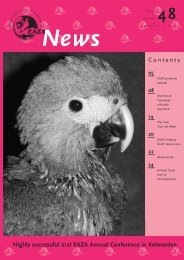EAZA News 57-12 - European Association of Zoos and Aquaria
EAZA News 57-12 - European Association of Zoos and Aquaria
EAZA News 57-12 - European Association of Zoos and Aquaria
You also want an ePaper? Increase the reach of your titles
YUMPU automatically turns print PDFs into web optimized ePapers that Google loves.
Bengt Holst, CBSG Europe, Copenhagen Zoo, Denmark<br />
Workshops for <strong>European</strong> species<br />
So far, CBSG Europe has primarily been involved in conservation workshops<br />
for exotic species such as the Malay tapir (Tapirus indicus), the<br />
Formosan pangolin (Manis pentadactyla pentadactyla) <strong>and</strong> the four<br />
species <strong>of</strong> lion tamarins (Leontopithecus spp.). The workshops were<br />
all urgently needed <strong>and</strong> resulted in conservation action plans that set<br />
priorities for the future conservation activities in the involved regions.<br />
However, it is now time to focus on <strong>European</strong> species as well. Several<br />
workshops are in preparation, but the first one to be conducted will be<br />
a PHVA (Population <strong>and</strong> Habitat Viability Assessment) workshop for<br />
the green toad (Bufo viridis) in Sweden. The workshop is scheduled for<br />
11 to 14 June 2007 <strong>and</strong> will be hosted by Nordens Ark, Hunnebostr<strong>and</strong>,<br />
Sweden, one <strong>of</strong> the institutions that have been heavily involved in<br />
captive breeding <strong>and</strong> reintroduction <strong>of</strong> this species for years.<br />
Towards a self-sustaining population <strong>of</strong> green toads<br />
The green toad was previously widely distributed in the southern-most<br />
part <strong>of</strong> Sweden, with over fifty known localities primarily in coastal<br />
areas. During the past fifty years the population has declined drastically;<br />
now numbering less than 400 adult specimens in three local populations.<br />
The reasons for this decline are not fully understood, but decreasing<br />
water quality <strong>and</strong> loss <strong>of</strong> breeding pools are most probably part <strong>of</strong> the<br />
explanation. In order to help the population increase again, reintroductions<br />
have been conducted at selected localities. However, in order for such<br />
activities to be efficient they need to become part <strong>of</strong> a more comprehensive<br />
plan, looking far into the future <strong>and</strong> taking all relevant threats <strong>and</strong><br />
opportunities into consideration.<br />
conservation<br />
CBSG Europe conducts conservation<br />
workshop for green toads<br />
A number <strong>of</strong> exciting working groups was formed at the annual meeting <strong>of</strong> CBSG in Halle, Germany, from<br />
24 to 27 August 2006. The reports <strong>of</strong> these working groups will be published in the next issue <strong>of</strong> the CBSG<br />
<strong>News</strong>letter. One <strong>of</strong> the working groups focussed on the development <strong>of</strong> a future action plan for CBSG Europe.<br />
As there was so much interest in this topic, the group needed to be divided into three subgroups, focussing<br />
on finances, future workshops <strong>and</strong> how to involve the CBSG membership in the daily work.<br />
CHANGES TO<br />
EXISTING TAGs<br />
<strong>EAZA</strong> Pelecaniformes tag<br />
Bjarne Klausen (vice-chair),<br />
Odense<br />
22 November 2006<br />
CHANGES TO<br />
EXISTING EEPs<br />
Pallas’ cat eep<br />
(Otocolobus manul )<br />
David Barclay, Edinburgh<br />
14 November 2006<br />
Moreover, it is important to include all major stakeholders in the necessary<br />
discussions <strong>and</strong> decisions regarding the plan, which must provide<br />
priorities in what needs to be done to secure a self-sustaining population<br />
<strong>of</strong> green toads in the future.<br />
Population <strong>and</strong> Habitat Viability Assessment (PHVA)<br />
The PHVA process is a very helpful <strong>and</strong> efficient tool for such a process.<br />
CBSG Europe will provide the necessary staff to conduct the workshop<br />
<strong>and</strong> Nordens Ark will provide the framework, including accommodation,<br />
meals <strong>and</strong> a suitable social atmosphere. The CBSG Europe staff will<br />
consist <strong>of</strong> two facilitators <strong>and</strong> two modellers. The modellers will make<br />
computer simulations for the population using a set <strong>of</strong> biological data<br />
(known or estimated). Such simulations help identify the most important<br />
threats <strong>and</strong> thus also the most important conservation actions to be<br />
taken. The facilitators take the participants through the necessary ‘brain<br />
exercises’ to get all relevant input on the table <strong>and</strong> after that to prioritise<br />
<strong>and</strong> organise the information into the final conservation action plan.<br />
CBSG Europe expects to have a workshop with forty to fifty participants,<br />
selected among specialists, decision makers <strong>and</strong> other stakeholders<br />
who will be influenced by the decisions made at the workshop. A special<br />
briefing book with relevant information about the status <strong>and</strong> threats,<br />
existing plans <strong>and</strong> local conditions will be produced by the CBSG Europe<br />
staff <strong>and</strong> will be distributed to all participants prior to the workshop.<br />
After the workshop the final PHVA report will be produced <strong>and</strong> distributed<br />
to all participants as well as to relevant local authorities for implementation.<br />
In addition it will be made available for download on the CBSG<br />
Europe website; www.cbsgeurope.eu •<br />
NEW ESBs<br />
Kowari esb<br />
(previously Kowari eep)<br />
( Dasycercus byrnei )<br />
Ewa Tresowska, Poznan<br />
10 November 2006<br />
CHANGES TO<br />
EXISTING ESBs<br />
Kea esb<br />
(Nestor notabilis)<br />
Kate Atwell, Bristol<br />
28 November 2006<br />
eaza news <strong>57</strong><br />
2007<br />
programme<br />
updates<br />
As approved by the EEP Committee<br />
31

















